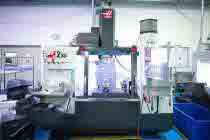We use multi-axis CNC machines every day to perform a variety of milling, cutting, turning and drilling functions. They are accurate workhorses used to make countless products for every conceivable application.
Because of their versatility, CNC machines can be configured in a number of ways. Regardless of their configuration or the products they make, most machines share some common features. In this infographic we look at the architecture of a typical CNC mill to understand how the various components work together so effectively.
Tool Carousel
Cutting tools of various types are mounted on tool holders, and these holders are manually loaded onto the carousel by the machine operator. After being programmed, the machine knows which tool is located in each position so it can select the correct cutter when needed for a particular milling operation.
Axes of Rotation
Complex parts require machines that are able to approach the workpiece from many different angles. These machines must be very rigid to hold close tolerances even as they rotate on many axes.
Spindle
The spindle holds the cutting tool firmly while rotating at 10,000 RPM or more. Strong bearings prevent the spindle from deflecting while it’s cutting – a major concern for precision machining. And the spindle must be able to release the collet quickly when it’s time for a tool change.
Cutting Fluid
Essential for getting a nice finish on most materials, cutting fluid is necessary for lubrication, cooling and removing waste material. We use non-petroleum, biodegradable fluid for environmentally responsible manufacturing.
Cutting Tools
Endmills, ball nose cutters, fly cutters, drills – these are all types of cutting tools used to shape the workpiece. They are made from very hard materials that can withstand intense pressure, heat and friction while remaining sharp and accurate.
Worktable
It’s impossible to machine a part accurately if it cannot be held rigidly in place. That is the job of the worktable, which may also be used to hold other specialty vises and clamps that are custom made for unique or hard-to-hold shapes that wouldn’t otherwise fit on a standard table.
For more information about how CNC machining can support your rapid prototypes and low-volume production, check out our CNC services page.
Chris Williams is the Content Editor at Michigan CNC Machining Parts, Inc.. He is passionate about writing and about developments in science, manufacturing and related technologies. He is also a certified English grammar snob.


